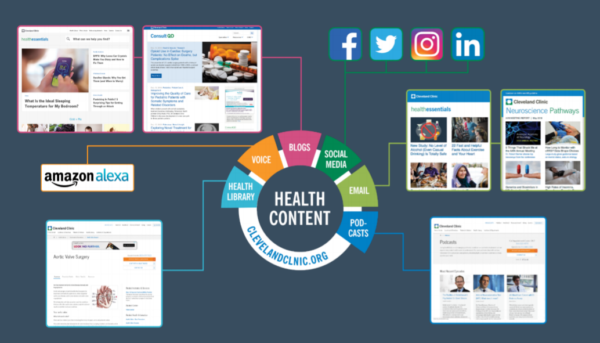 We’ve all worked on projects, right?
We’ve all worked on projects, right?
They tend to consist of these elements: deadlines, timelines, due dates, deliverables, checklists, and project status meetings.
What happens when one project is done? You move on to the next one.
And that begs the question – can your content marketing achieve its potential if structured as a series of projects?
For Amanda Todorovich and Matt Bakaitis, the answer is no. A project-based approach to content marketing gets the job done but won’t result in exceptional or even differentiated content.
Amanda, senior director, content, at Cleveland Clinic and Matt, senior director, content engineering, at Cleveland Clinic, say that with content marketing, you’re never really done and never have a single deadline.
Content marketing is a living, breathing animal. Amanda and Matt encourage you to think of it more like a software product than a project. They detail their product-oriented approach in a ContentTECH presentation, Why You Need to Be Thinking Products, Not Projects.
Think of #contentmarketing more like a product than a series of projects. @amandtodo @mbakaitis #ContentTECH Click To Tweet
In this article, I share some of their insights and process.
Shift content marketing to a product mindset
Amanda shares this diagram of Cleveland Clinic’s content formats and distribution channels:
If you produce a diagram for your organization, it would probably have similar tactics:
- Podcasts.
- Email.
- Social media.
- Blogs.
- Voice (e.g., smart speakers).
- Content library (e.g., articles).
How this approach might differ from yours is how Amanda thinks of each channel. She considers each channel a separate product. For example, with an email newsletter, payment is a user’s email address.
When Amanda sends the newsletter, she delivers the product. She asks herself, “Is this product delivering value to my customers? Is it truly something that customers want?”
Similarly, Amanda considers each social media channel a product: “Your customers have chosen to be a customer of that page. Are you delivering value that they would pay for or is it a scrapbook of what’s going on at your institution?”
Treat content hub as a product
When Amanda joined Cleveland Clinic, she took a product-oriented focus to its content hub, Health Essentials. Just as product managers create a mission statement for their products, Amanda created one for Health Essentials: “To engage users in daily conversation using health, wellness, and clinical content that is unique to Cleveland Clinic.”

This simple mission statement has persisted for seven years, growing the Health Essentials site from zero visitors in 2012 to more than 7 million monthly visitors today. “There was no change in strategy and those numbers did not come from creating more content. We remained consistent, with three to five articles every single day for the last seven years,” Amanda explains.
As noted, a product-oriented approach to content marketing means you’re never really done. Even during a period of Health Essentials’ high traffic growth, Amanda paused to ask what a product manager would ask:
- What are we?
- Who are we?
- What do we want to be?
- What do we want this product to say to our audiences?
The answers led Amanda and team to redesign the site. The changes were rolled out in an evolutionary manner.
A product-oriented approach to #contentmarketing means you’re never really done. @amandatodo #ContentTECH Click To Tweet
Amanda says, “The evolution was about introducing features and efficiencies to our audiences, to see where it was worth going a little deeper and where we could offer a little more.”
For Health Essentials, the primary audience persona is a mom who makes medical decisions for herself and her family. Amanda and team constantly think about how to serve this mom the topics in which she is interested daily.
Use an iterative, product-focused approach
A product-focused approach to content brings clarity to the process. “It allows our strategy to be enacted in a way that thinks about the customer and provides value in every decision we make. All of the data we have in Google Analytics, social media analytics, and more, our customers are signaling to us what they want,” says Amanda.
The product-focused approach leads her to ask questions like:
- How can we be better?
- How can we deliver more value every time?
In addition to thinking of content marketing as a product, Matt spoke about two content-related product offerings recently launched by Cleveland Clinic:
- Outcomes – giving access to research that details patient progress after they leave the clinic.
- Clinical trials – giving access to research about clinical trials.
According to Amanda, “The evolution of our customers is a really important part of this. It’s not just about iterating what you deliver, it’s iterating your understanding of who your customer is, and what problems you’re solving, and what kind of experiences you’re providing.”
Along those lines, the original Outcomes product came in the form of printed books – over 100 pages each and expensive to print. The printed books also weren’t easily searchable. The result was a poorly received product that probably ended up in recycling bins.
Matt’s team discovered that the data was stored online and could be dynamically queried. Using an iterative process, they built an online version of the book. “They created an experience for a doctor who needs that information when they’re making a patient referral in their office. Doctors can access it right from their phones,” says Amanda.
With products built and launched, Amanda, Matt and team look at metrics every day. Team members come to meetings prepared to discuss the metrics they’re responsible for. “We huddle every morning and talk about what happened yesterday, what did we learn, what are we testing today, how do we get better tomorrow. This is not big, monthly reports, it’s a daily discussion of metrics,” says Amanda.
Each meeting analyzes whether the team is on track to hit the performance goals – if not, the team members collaboratively determine the best course of action.
Create an inclusive environment
Can you imagine someone in engineering or legal saying to you, “Hey, I’d love to sit in on your marketing project meeting,”? It’s never happened in all my time working in marketing. And that’s because nothing in a marketing project meeting excites someone from a different department.
Project meetings are a thing that someone else owns, according to Matt. If, instead, you publicize the product you’re building and tell others that you’re meeting to discuss product initiatives, they might want to join.
Why? They feel like they’re part of the product mission. “Products give ownership to everybody. They allow participation in ways that you can’t really do with projects. As soon as you start to work with people in a product setting, they start to talk about it with others and suddenly lots of people come out of the woodwork,” says Matt.
With products, it’s easy for Matt and Amanda to go to leadership and say, “Who on your team should be a part of this?” And as word spreads, Matt and Amanda may have engineering and legal ask to attend the meetings.
Imagine if engineering asks to attend mkting meetings. Product approach makes that possible. @mbakaitis Click To Tweet
According to Matt, “When we walked outside of marketing, we were explaining our new products in ways they could picture. Colleagues could put themselves in the shoes of a patient looking for a clinical trial. And that made colleagues tell us that they want to be part of the product team,” says Matt.
Are you ready to build great products?
I’ve held related roles: product manager, product marketer, and content marketer. Truth be told, I never took a product-centric approach to content marketing, even though my background suggests I could have.
At a fundamental level, content marketing and product management center on understanding and serving a target customer. Top content marketers and product managers excel at creating useful experiences that delight their users.
Amanda and Matt, however, take the product-centric approach to content marketing to a new level. It’s central to the content marketing operation and even persists beyond the content and content engineering teams.
What are your thoughts on a product-centric approach to content marketing and what are the first steps you might take? Share your thoughts in the comments.
Here’s an excerpt from Amanda and Matt’s talk:
Learn from Amanda Todorovich in person as she educates on how to transform your corporate blog into an owned media platform at Content Marketing World Sept. 3-6. Register today using code CMIBLOG100 to save $100. In the health care industry? Make plans to attend the #CMWorld Cleveland Clinic Health Care Summit on Sept. 6.
Cover image by Joseph Kalinowski/Content Marketing Institute
 Click to enlarge
Click to enlarge Click to enlarge
Click to enlarge